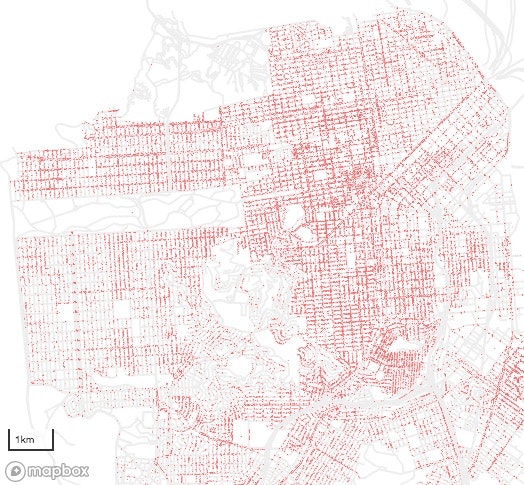こんにちは。
下記のベクター地図タイル動的配信サーバを見つけたので動かしてみました。クライアント側の表示は MapboxGL を利用しました(そこの説明と同じです)1。
"An example Go app for dynamically serving MapboxGL vector tiles" (GitHub)
- https://github.com/kkdd/go-vtile-example/tree/master (上記へ少し手を加えたもの)
$ go run main.go
number of points = 91586
main.go
main.go に少し手を加えています。地理座標の内部表現(loc)はBraun投影した値です。
\begin{align}
x &= \frac{\lambda}{2 \pi} \\
y &= \tan \frac{\phi}{2}
\end{align}
main.go
package main
import (
"os"
"compress/gzip"
"encoding/csv"
"errors"
"fmt"
"io/ioutil"
"log"
"math"
"net/http"
"regexp"
"strconv"
"strings"
"github.com/golang/protobuf/proto"
"./vector_tile"
)
func cmdEnc(id uint32, count uint32) uint32 {
return (id & 0x7) | (count << 3)
}
func moveTo(count uint32) uint32 {
return cmdEnc(1, count)
}
func lineTo(count uint32) uint32 {
return cmdEnc(2, count)
}
func closePath(count uint32) uint32 {
return cmdEnc(7, count)
}
func paramEnc(value int32) int32 {
return (value << 1) ^ (value >> 31)
}
func createTileWithPoints(points []XY, bounds XYZ) ([]byte, error) {
layerName := "points"
var pX, pY int32
var layerVersion = vector_tile.Default_Tile_Layer_Version
featureType := vector_tile.Tile_POINT
var extent = vector_tile.Default_Tile_Layer_Extent
fext := float64(extent);
var geometry []uint32
geometry = append(geometry, 0) // npoints=0 (dummy)
x, y := tileToBoundingBox(bounds)
for _, point := range points {
if point.x >= x[0] && point.x < x[1] && point.y >= y[0] && point.y < y[1] {
p := locToTileXY(point, bounds)
prevX := pX
prevY := pY
pX = int32(fext*p.x+0.5)
pY = int32(fext*p.y+0.5)
geometry = append(geometry, uint32(paramEnc(pX-prevX)))
geometry = append(geometry, uint32(paramEnc(pY-prevY)))
}
}
npoints := (uint32(len(geometry))-1)/2
geometry[0] = moveTo(npoints)
tile := &vector_tile.Tile{}
tile.Layers = []*vector_tile.Tile_Layer{
&vector_tile.Tile_Layer{
Version: &layerVersion,
Name: &layerName,
Extent: &extent,
Features: []*vector_tile.Tile_Feature{
&vector_tile.Tile_Feature{
Tags: []uint32{},
Type: &featureType,
Geometry: geometry,
},
},
},
}
return proto.Marshal(tile)
}
// return loc: Braun projection
func lonLatToLoc(lonLat XY) (XY) {
var loc XY
loc.x = lonLat.x/360
loc.y = math.Tan(lonLat.y/360 * math.Pi) // Braun projection
return loc
}
func locToLonLat(loc XY) (XY) {
var lonLat XY
lonLat.x = loc.x * 360
lonLat.y = math.Atan(loc.y) * 360/math.Pi // inverse Braun projection
return lonLat
}
// relative position in a tile
func locToTileXY(loc XY, tile XYZ) (XY) {
pos := loc
pos.y = math.Log((1+pos.y)/(1-pos.y))/math.Pi/2 // web mercator
pos.x = ( pos.x + 0.5) * tile.z - tile.x
pos.y = (-pos.y + 0.5) * tile.z - tile.y
return pos
}
func tileToLoc(tile XYZ) (XY) {
var loc XY
loc.x = tile.x / tile.z - 0.5
loc.y = -(tile.y / tile.z - 0.5)
loc.y = 1 - 2/(math.Exp(loc.y*math.Pi*2)+1) // inverse web mercator
return loc
}
func tileToBoundingBox(tile XYZ) ([]float64, []float64) {
upper := tileToLoc(tile)
lower := tileToLoc(XYZ{x: tile.x, y: tile.y+1, z: tile.z})
return []float64{upper.x, upper.x + 1/tile.z}, []float64{lower.y, upper.y}
}
const RE = 6378137.0 // GRS80
const FE = 1/298.257223563 // IS-GPS
const E2 = FE * (2 - FE)
// geographic distance between two points
// inputs: p = lonLatToLoc(lonLat1), q = lonLatToLoc(lonLat2)
func distance(p XY, q XY) (float64) {
y2 := square((p.y + q.y) / 2)
coslat := (1 - y2) / (1 + y2)
w2 := 1 / (1 - E2 * (1 - coslat * coslat))
dx := (p.x - q.x) * coslat
dy := (p.y - q.y) * 2 / (1 + y2) * w2 * (1 - E2)
return math.Sqrt(hypotSquared(dx, dy) * w2) * 2 * math.Pi * RE
}
func square(x float64) (float64) {
return x * x
}
func hypotSquared(x float64, y float64) (float64) {
return x * x + y * y
}
// Takes a string of the form `<z>/<x>/<y>` (for example, 1/2/3) and returns
// the individual uint32 values for x, y, and z if there was no error.
// Otherwise, err is set to a non `nil` value and x, y, z are set to 0.
func pathToTile(path string) (XYZ, error) {
xyzReg := regexp.MustCompile("(?P<z>[0-9]+)/(?P<x>[0-9]+)/(?P<y>[0-9]+)")
matches := xyzReg.FindStringSubmatch(path)
if len(matches) == 0 {
return XYZ{}, errors.New("Unable to parse path as tile")
}
x, err := strconv.ParseUint(matches[2], 10, 32)
if err != nil {
return XYZ{}, err
}
y, err := strconv.ParseUint(matches[3], 10, 32)
if err != nil {
return XYZ{}, err
}
z, err := strconv.ParseUint(matches[1], 10, 32)
if err != nil {
return XYZ{}, err
}
return XYZ{x: float64(x), y: float64(y), z: math.Pow(2, float64(z))}, nil
}
// A XYZ is a struct that holds tile's coordinates and zoom scale.
type XYZ struct {
x float64
y float64
z float64
}
// A XY is a struct that holds a geographic location.
type XY struct {
x float64
y float64
}
// Tree a struct holder for tree information.
type Tree struct {
lonlat XY
species string
}
// trees.csv: TreeID,qLegalStatus,qSpecies,qAddress,SiteOrder,qSiteInfo,PlantType,qCaretaker,qCareAssistant,PlantDate,DBH,PlotSize,PermitNotes,XCoord,YCoord,Latitude,Longitude,Location
const SPECIES = 2
const LATITUDE = 15
const LONGITUDE = 16
func loadTrees() []Tree {
content, err := ioutil.ReadFile("./trees.csv")
if err != nil {
log.Fatal(err)
}
r := csv.NewReader(strings.NewReader(string(content[:])))
records, err := r.ReadAll()
if err != nil {
log.Fatal(err)
}
var trees []Tree
for _, record := range records[1:] {
species := record[SPECIES]
lon, _ := strconv.ParseFloat(record[LONGITUDE], 64)
lat, _ := strconv.ParseFloat(record[LATITUDE], 64)
trees = append(trees, Tree{lonlat: XY{x: lon, y: lat}, species: species})
}
return trees
}
func main() {
trees := loadTrees()
points := make([]XY, len(trees), len(trees))
for i, tree := range trees {
points[i] = lonLatToLoc(tree.lonlat)
}
fmt.Println("number of points =", len(points))
mux := http.NewServeMux()
// Handle requests for urls of the form `/tiles/{z}/{x}/{y}` and returns
// the vector tile for the even tile x, y, and z coordinates.
tileBase := "/tiles/"
mux.HandleFunc(tileBase, func(w http.ResponseWriter, r *http.Request) {
log.Printf("url: %s", r.URL.Path)
tile, err := pathToTile(r.URL.Path[len(tileBase):])
if err != nil {
http.Error(w, "Invalid tile url", 400)
return
}
data, err := createTileWithPoints(points, tile)
if err != nil {
log.Fatal("error generating tile", err)
}
// All this APi to be requests from other domains.
w.Header().Set("Content-Type", "application/x-protobuf")
w.Header().Set("Access-Control-Allow-Origin", "*")
w.Header().Set("Access-Control-Allow-Methods", "GET, POST, OPTIONS")
w.Write(data)
})
log.Fatal(http.ListenAndServe(":8080", mux))
}
-
なお Leaflet.VectorGrid 利用だと、現状はこの例の multi points データに対応できていないようです。 ↩
